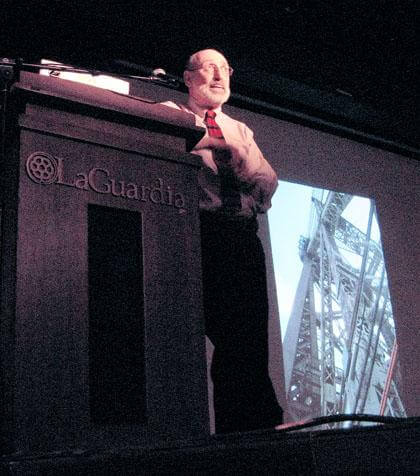By Jeremy Walsh
Whether it’s a “groovy pop” song, a breathless passage in a definitive 20th century novel or a somber moment in a World War II drama, the Queensboro Bridge has etched itself into the consciousness of New Yorkers. Now the iconic structure is celebrating its centennial.
The nonprofit NYC Bridge Centennial Commission is planning a series of lectures, walking tours and even a fireworks display at the bridge during the first month of June to commemorate the original opening ceremonies.
The 6,855−foot cantilever truss bridge opened to traffic on March 30, 1909, after nearly eight years of construction and the deaths of 50 workers, according to the Greater Astoria Historical Society.
Bob Singleton, former president of the GAHS, called the bridge “probably the single−most important event in the creation of modern Queens,” noting it stimulated massive growth in the borough in the era after it was incorporated as part of the city.
“For decades, whenever any serious article about Queens came out — be it population, housing starts, industrial output — the Queensboro Bridge was always the benchmark,” he said. “This was Queens before the bridge was built. This was Queens after the bridge.”
Writer F. Scott Fitzgerald incorporated it in the American mythology of “The Great Gatsby” when he wrote “the city seen from the Queensboro Bridge is always the city seen for the first time, in its first wild promise of all the mystery and the beauty in the world.” Pop−folk duo Simon and Garfunkel immortalized the span in their song “59th Street Bridge Song (Feelin’ Groovy).”
It also figured large in the imagination of New Yorkers like architectural historian Barry Lewis, who spoke at a centennial celebration for the bridge Monday night at LaGuardia Community College. As a child growing up in Woodhaven, Lewis would often curl up on the rear window ledge of his father’s car as they drove across the bridge.
“The constant repetition of the framework, I would just watch it until I fell asleep,” he said, noting the ornate metalwork and spires of the bridge were the last gasp of 19th−century Victorian metalwork architecture. “The Queensboro Bridge was the last of its kind.”
He said he also recognized the bridge in the middle of a scene from the recent film “The Reader” set in Germany in 1958.
“How could I have possibly have guessed that in the middle of Berlin, they would have the Queensboro Bridge?” he said. “It’s that distinctive.”
The Queensboro Bridge was designated as a national landmark in 1973 and an extensive rehabilitation effort was launched in 1978 after bridge inspectors noticed significant deterioration.
Sam Schwartz, head of the city DOT in the 1980s, described one tour of the bridge he gave to a number of elected officials to demonstrate the level of decay among the metal.
“I hit the bridge and the hammer went right through the web of steel beams,” he said. “That’s how close we were to losing the bridge.”
Reach reporter Jeremy Walsh by e−mail at jewalsh@cnglocal.com or by phone at 718−229−0300, Ext. 154.

























